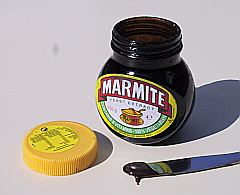jaydventer
Active Member
hi all, i know there's been a few threads speculating the possibility of making one's own marmite from leftover trub, but don't think anyone's come up with a close recipe yet!
so i was thinking, since the whole method is "top secret", maybe if those of us who actually like marmite, all try different methods and put our findings together, we just might discover "the secret"...
so, all i've gathered is:
from marmite's site:
"Making Marmite
The basic production method has changed little since Marmite was first invented. Basically, the used brewer's yeast is broken down to release soluble amino acids and proteins. This soluble material is then concentrated and filtered a few times before going through a unique (and top secret) process for flavour development.
At the end of all this, we end up with yeast extract paste - nearly Marmite but not quite. The finishing touches make all the difference. We add an extra blend of vitamins, vegetable and spice extracts to create the taste your mouth adores!"
from wikipedia:
"Manufacture
Whilst the actual process is secret, the general method for making yeast extract on a commercial scale is to add salt to a suspension of yeast making the solution hypertonic, which leads to the cells shrivelling up; this triggers "autolysis", in which the yeast self-destructs. The dying yeast cells are then heated to complete their breakdown, after which the husks (yeast have thick cell walls which would detract from the smooth texture of the final product) are separated out. As with other yeast extracts, Marmite contains free glutamic acids, which are analogous to monosodium glutamate"
and then Eadweard on another forum (www.jimsbeerkit.co.uk) tried that:
"I tried making marmite by boiling down yeast at the end of a brew and adding some salt. I didn't work. I had, in fact, made the most revolting thing I've ever tasted. It was more concentrated hop bitterness than marmite. If you've ever tried eating a hop pellet you may have some idea what it tasted like. Anyway, it was totally foul, even in very small doses."
so i think we should all try different methods, like switch it around, first add the salt, so the yeasties die, then heat it up...
maybe experiment with different temperatures, and strain the whole mess etc etc..
maybe that's why the guy's experiment tasted bad, because the yeast husks/ cell walls were still there?? how to "seperate" them?
we might need some help from biologists or something.
and then log our findings here...hehe
opensource homebrewmite ver 0.0.0.1
don't exclude the possibility of industrial espionage, maybe someone knows someone who works for the company or something...
so i was thinking, since the whole method is "top secret", maybe if those of us who actually like marmite, all try different methods and put our findings together, we just might discover "the secret"...
so, all i've gathered is:
from marmite's site:
"Making Marmite
The basic production method has changed little since Marmite was first invented. Basically, the used brewer's yeast is broken down to release soluble amino acids and proteins. This soluble material is then concentrated and filtered a few times before going through a unique (and top secret) process for flavour development.
At the end of all this, we end up with yeast extract paste - nearly Marmite but not quite. The finishing touches make all the difference. We add an extra blend of vitamins, vegetable and spice extracts to create the taste your mouth adores!"
from wikipedia:
"Manufacture
Whilst the actual process is secret, the general method for making yeast extract on a commercial scale is to add salt to a suspension of yeast making the solution hypertonic, which leads to the cells shrivelling up; this triggers "autolysis", in which the yeast self-destructs. The dying yeast cells are then heated to complete their breakdown, after which the husks (yeast have thick cell walls which would detract from the smooth texture of the final product) are separated out. As with other yeast extracts, Marmite contains free glutamic acids, which are analogous to monosodium glutamate"
and then Eadweard on another forum (www.jimsbeerkit.co.uk) tried that:
"I tried making marmite by boiling down yeast at the end of a brew and adding some salt. I didn't work. I had, in fact, made the most revolting thing I've ever tasted. It was more concentrated hop bitterness than marmite. If you've ever tried eating a hop pellet you may have some idea what it tasted like. Anyway, it was totally foul, even in very small doses."
so i think we should all try different methods, like switch it around, first add the salt, so the yeasties die, then heat it up...
maybe experiment with different temperatures, and strain the whole mess etc etc..
maybe that's why the guy's experiment tasted bad, because the yeast husks/ cell walls were still there?? how to "seperate" them?
we might need some help from biologists or something.
and then log our findings here...hehe
opensource homebrewmite ver 0.0.0.1
don't exclude the possibility of industrial espionage, maybe someone knows someone who works for the company or something...



